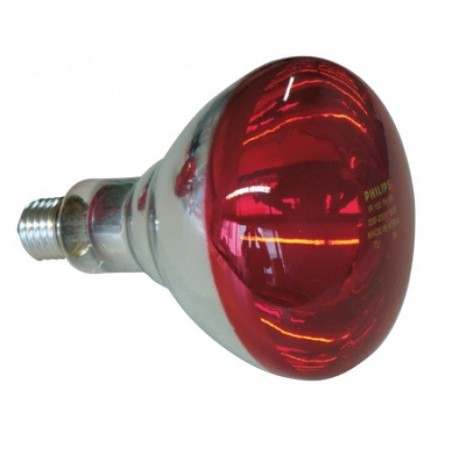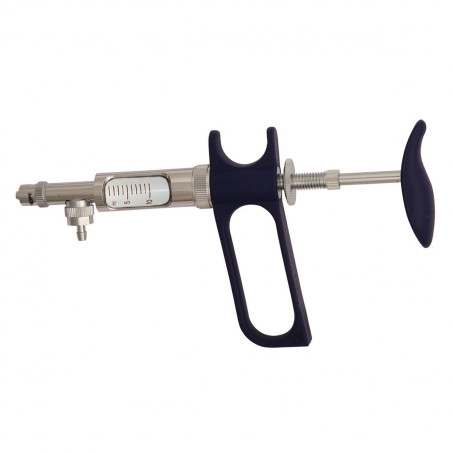Introduction
Nowadays, the Chinese pig industry is experiencing a dramatic upgrade. As the environmental policies are getting every time stricter and as there is a fierce competition, many small scale farms are disappearing while big companies are expanding and building many modern farms. However, startup farms face serious disease challenges, such as PRRS, PRV (Aujeszky´s disease), PED, CSF, APP etc. Those pathogens are still not eradicated from China.

Unlike the old design farms, the modern startup farms may have less pressure of respiratory diseases infection in winter as they usually have good ventilation design. However, the clinical case described here is an App outbreak in a startup farm with modernized ventilation design.
Farm description
This 1200 farrow-to finish sow farm was a startup operation located at a rural mountain area with low pig density and strict biosecurity policies with the objective of keeping it free of PED, PRRS, PRV, CSF, App, Mycoplasma hyopneumoniae etc. infection. The farm has been fully on production since September 2017 but the slurry system was still not completely built yet.
Case Onset
The farm manager contacted the veterinarian as there were some clinical problems on gestating sows described as short cough with breathing difficulties and a sudden increase on mortality. A total number of 17 gestating sows died from 8th to 10th December. The affected sows opened their mouth to breath before dying (video 1). One gestating gilt had haemorrhage from the nose and abdominal breathing (video 2). Almost all of the dead animals had nasal haemorrhage and purulent discharges from the nose (Fig 1). 9 dead sows belonged to week 35 and 36 batch which was housed at the center of the barn (Fig 2). Approximately 25% gestating sows were sick, off feed, with fever up to 40.5º C and abdominal breathing.
Video 1: The gestating sow has breathing difficulties, abdominal breathing with open mouth to help breathing.
Video 2: The gestating gilt has nasal blood and abdominal breathing.
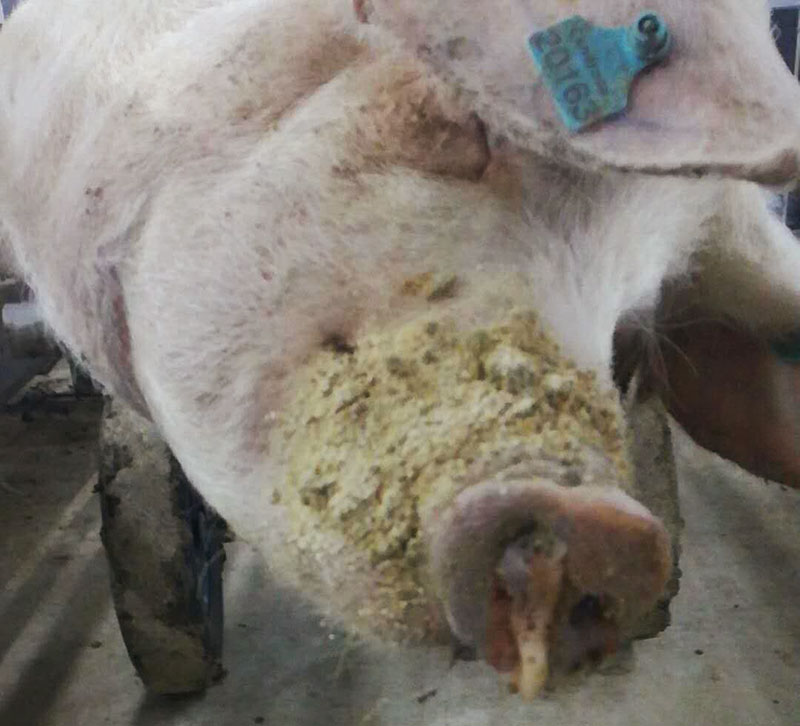
Necropsy findings
Five dead gestating sows were opened. Necropsy findings of all of them were similar and showed dark consolidated demarcated lesions in the middle, cranial and caudal lobes of the lungs. Two sows presented fibrinous pleurisy and pericarditis (Fig 3). All of them had petechial hemorrhage on heart (Fig 4). Blood stained froth could be seen at mouth and nostrils.
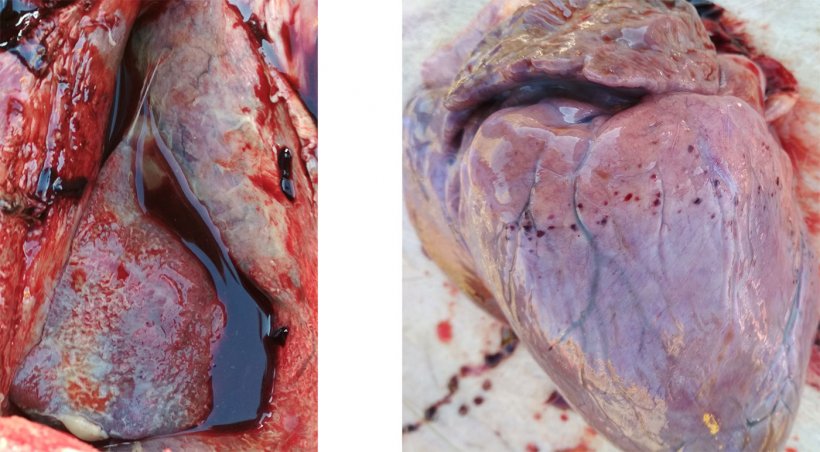
Risk factors investigation
Before intervention was defined, the risk factors predisposing to respiratory diseases were studied.
Animals: No relation with sow breed was noticed.
Environment: No sows in farrowing barn had clinical signs but all affected animals were housed at the gestation barn therefore showing a strong relation with facilities management. The air quality at the farrowing facilities was much better than gestation. There was no heating system at the gestation barn, leading to a reduction on ventilation rate in winter.
Location: The sick animals concentrated at the center of the gestation barn where the level of slurry was very high, close to the slats and the ammonia levels was high enough to irritate the eyes, while the slurry of the other pens, in comparison, was not so high.
Feed: The gestation feed had been changed from pelleted to meal. The feedback of the employee was that this change had increased the dust level in the barn.
Water: The water source in gestation was the same one as the other barn and the water pipes were cleaned in a routine basis.
Diagnosis
According to the clinical signs of high fever, abdominal breathing, loss of appetite, presence in all the dead sows of blood/purulent discharge from nose and the necropsy findings showing fibrinous pleurisy and pericarditis, preliminary diagnosis was App and the treatment plan was made accordingly. Histopathology of lung showed alveoli full of fluid and inflammatory cell accumulation, which demonstrate bacterial pneumonia (Fig 5). The bacteriology of the lung culture confirmed the presence of App.
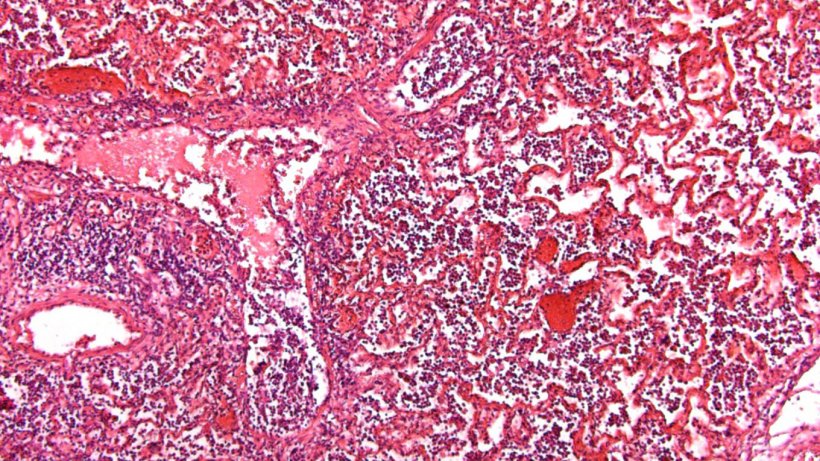
Intervention
Antibiotic implementation: The initial instruction to farm staff was to inject with ceftiufur all the sick sows. Considering that the sow losses did not stop, the veterinarian performed a farm visit. During his visit and after evaluating that 25 % of the sows were sick, all the animals in the gestation barn were treated with ceftiofur immediately and Penicillin was administrated for the next two days. Amoxillin was provided via water for 7 days.
Ventilation: The room temperature set was reduced from 15ºC to 10ºC gradually to improve the ventilation.
Construction: The slurry processing system was fully constructed, although with financial pressure, and the slurry was removed under the slat.
Vaccination: The application of an App vaccine was suggested with the objective of performing a blanket massive vaccinate to achieve a long term control. The first vaccine was injected on the 17 December and repeated 3 weeks later.
After the mass injection of the sow herd with ceftiofur, during the vet visit, there were no more sow death losses till now.
Discussion
The farm manager contacted the veterinarian due to the sudden death of 6 sows on the 8 Dec and the emergency action plan was made before visiting the farm based on the clinical signs that were strongly indicative of an App suspicion. The emergency action plan was to use ceftiofur to treat all the sick animals and medicate the water with amoxicillin. However, the mortality of sows was still out of control and therefore the veterinarian visited the farm. During his visit he observed that only about 10 sows had been treated using ceftiofur according to the treatment records while approximately 250 gestating sows were sick, which accounts for 25% of all the gestating sows during the visit.
The reason why so many sick sows had not been treated was not only that there were new employees with low level of experience on animal observation but also because these employees were concerned about the cost of ceftiofur injection, which is about 40 RMB/head (around 6 $/head).
As the China pig industry is upgrading and more new farms are being built, there is a big need of training for all the new employees in China. Besides, the traditional opinion of health management in Chinese pig farming is to give low doses of antibiotics to pigs in a routine basis and try to prevent the challenges the farm is facing and the potential infection risks. However, the antibiotic resistance and production results are getting worse and the medicine costs are becoming higher.
How to use antibiotics wisely and appropriately in Chinese pig farming is still a problem that needs to be addressed.
Conclusions
App is neither a new disease in China, nor the most pathogenic disease compare with PRRS, PRV,PED, CSF etc. Still, the serious problem and the production losses that we have seen in this case and that could have been avoided, demonstrates the underlying problem of new employees training and the need for a correct set up concept of medicine use in China.






